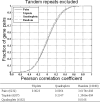Co-expression of neighboring genes in the zebrafish (Danio rerio) genome
- PMID: 20111688
- PMCID: PMC2812831
- DOI: 10.3390/ijms10083658
Co-expression of neighboring genes in the zebrafish (Danio rerio) genome
Abstract
Neighboring genes in the eukaryotic genome have a tendency to express concurrently, and the proximity of two adjacent genes is often considered a possible explanation for their co-expression behavior. However, the actual contribution of the physical distance between two genes to their co-expression behavior has yet to be defined. To further investigate this issue, we studied the co-expression of neighboring genes in zebrafish, which has a compact genome and has experienced a whole genome duplication event. Our analysis shows that the proportion of highly co-expressed neighboring pairs (Pearson's correlation coefficient R>0.7) is low (0.24% approximately 0.67%); however, it is still significantly higher than that of random pairs. In particular, the statistical result implies that the co-expression tendency of neighboring pairs is negatively correlated with their physical distance. Our findings therefore suggest that physical distance may play an important role in the co-expression of neighboring genes. Possible mechanisms related to the neighboring genes' co-expression are also discussed.
Keywords: co-expression; gene expression; neighboring genes; promoter; zebrafish.
Figures





Similar articles
-
Positive correlation between gene coexpression and positional clustering in the zebrafish genome.BMC Genomics. 2009 Jan 22;10:42. doi: 10.1186/1471-2164-10-42. BMC Genomics. 2009. PMID: 19159490 Free PMC article.
-
Identification of p53-target genes in Danio rerio.Sci Rep. 2016 Sep 1;6:32474. doi: 10.1038/srep32474. Sci Rep. 2016. PMID: 27581768 Free PMC article.
-
Differential transcriptional modulation of duplicated fatty acid-binding protein genes by dietary fatty acids in zebrafish (Danio rerio): evidence for subfunctionalization or neofunctionalization of duplicated genes.BMC Evol Biol. 2009 Sep 2;9:219. doi: 10.1186/1471-2148-9-219. BMC Evol Biol. 2009. PMID: 19725974 Free PMC article.
-
Identification of a new pebp2alphaA2 isoform from zebrafish runx2 capable of inducing osteocalcin gene expression in vitro.J Bone Miner Res. 2005 Aug;20(8):1440-53. doi: 10.1359/JBMR.050318. Epub 2005 Mar 21. J Bone Miner Res. 2005. PMID: 16007341
-
Mass spectrometry for proteomics-based investigation using the zebrafish vertebrate model system.Adv Exp Med Biol. 2014;806:331-40. doi: 10.1007/978-3-319-06068-2_15. Adv Exp Med Biol. 2014. PMID: 24952190 Review.
Cited by
-
The adjacent positioning of co-regulated gene pairs is widely conserved across eukaryotes.BMC Genomics. 2012 Oct 10;13:546. doi: 10.1186/1471-2164-13-546. BMC Genomics. 2012. PMID: 23051624 Free PMC article.
-
Transcription Profiles of Age-at-Maturity-Associated Genes Suggest Cell Fate Commitment Regulation as a Key Factor in the Atlantic Salmon Maturation Process.G3 (Bethesda). 2020 Jan 7;10(1):235-246. doi: 10.1534/g3.119.400882. G3 (Bethesda). 2020. PMID: 31740454 Free PMC article.
-
A plant cell death-inducing protein from litchi interacts with Peronophythora litchii pectate lyase and enhances plant resistance.Nat Commun. 2024 Jan 2;15(1):22. doi: 10.1038/s41467-023-44356-y. Nat Commun. 2024. PMID: 38167822 Free PMC article.
-
Comprehensive bioinformatics analysis of the characterization and determination underlying mechanisms of over-expression and co-expression of genes residing on 20q in colorectal cancer.Oncotarget. 2017 Aug 10;8(45):78642-78659. doi: 10.18632/oncotarget.20204. eCollection 2017 Oct 3. Oncotarget. 2017. PMID: 29108255 Free PMC article.
-
Functionally Related Genes Cluster into Genomic Regions That Coordinate Transcription at a Distance in Saccharomyces cerevisiae.mSphere. 2019 Mar 13;4(2):e00063-19. doi: 10.1128/mSphere.00063-19. mSphere. 2019. PMID: 30867326 Free PMC article.
References
-
- Semon M, Duret L. Evolutionary origin and maintenance of coexpressed gene clusters in mammals. Mol. Biol. Evol. 2006;23:1715–1723. - PubMed
-
- Hurst LD, Pal C, Lercher MJ. The evolutionary dynamics of eukaryotic gene order. Nat. Rev. Genet. 2004;5:299–310. - PubMed
-
- Lercher MJ, Urrutia AO, Hurst LD. Clustering of housekeeping genes provides a unified model of gene order in the human genome. Nat. Genet. 2002;31:180–183. - PubMed
Publication types
MeSH terms
Substances
LinkOut - more resources
Full Text Sources

